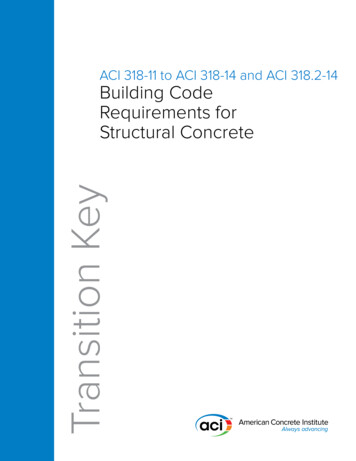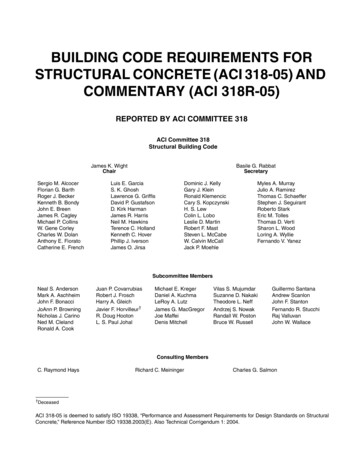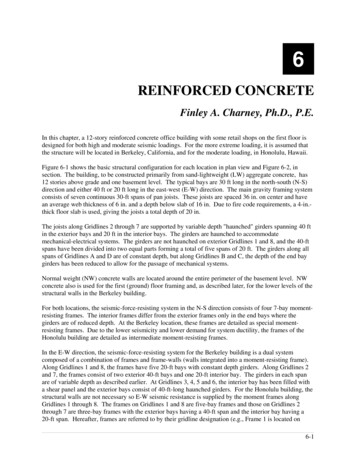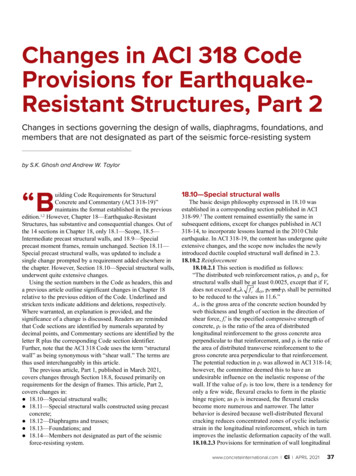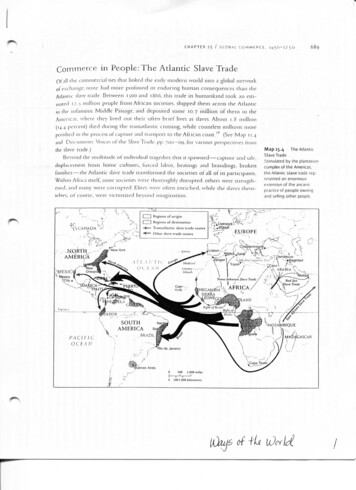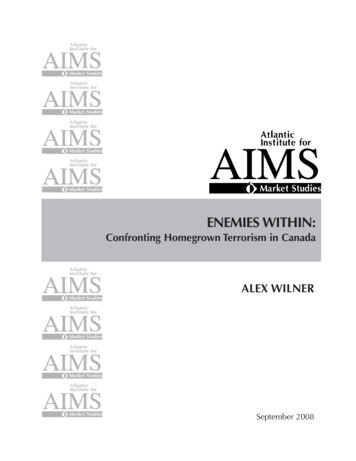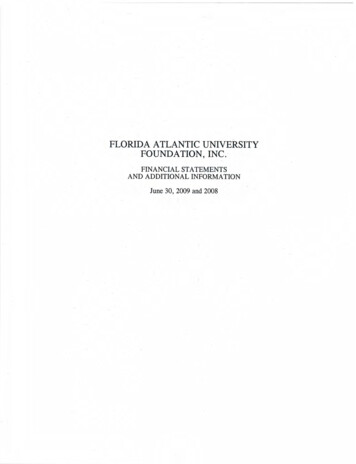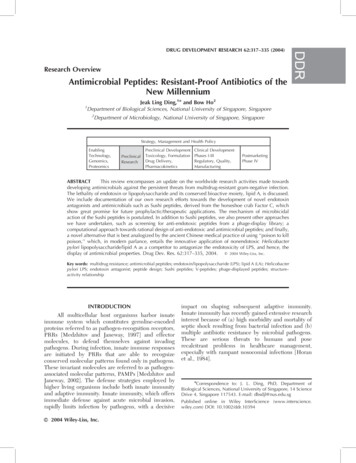
Transcription
Research OverviewAntimicrobial Peptides: Resistant-Proof Antibiotics of theNew Millennium1DDRDRUG DEVELOPMENT RESEARCH 62:317–335 (2004)Jeak Ling Ding,1n and Bow Ho2Department of Biological Sciences, National University of Singapore, Singapore2Department of Microbiology, National University of Singapore, SingaporeStrategy, Management and Health nicalResearchPreclinical DevelopmentToxicology, FormulationDrug Delivery,PharmacokineticsClinical DevelopmentPhases I-IIIRegulatory, Quality,ManufacturingPostmarketingPhase IVABSTRACTThis review encompasses an update on the worldwide research activities made towardsdeveloping antimicrobials against the persistent threats from multidrug-resistant gram-negative infection.The lethality of endotoxin or lipopolysaccharide and its conserved bioactive moiety, lipid A, is discussed.We include documentation of our own research efforts towards the development of novel endotoxinantagonists and antimicrobials such as Sushi peptides, derived from the horseshoe crab Factor C, whichshow great promise for future prophylactic/therapeutic applications. The mechanism of microbicidalaction of the Sushi peptides is postulated. In addition to Sushi peptides, we also present other approacheswe have undertaken, such as screening for anti-endotoxic peptides from a phage-display library; acomputational approach towards rational design of anti-endotoxic and antimicrobial peptides; and finally,a novel alternative that is best analogized by the ancient Chinese medical practice of using ‘‘poison to killpoison,’’ which, in modern parlance, entails the innovative application of nonendotoxic Helicobacterpylori lipopolysaccharide/lipid A as a competitor to antagonize the endotoxicity of LPS, and hence, thec 2004 Wiley-Liss, Inc.display of antimicrobial properties. Drug Dev. Res. 62:317–335, 2004. Key words: multidrug resistance; antimicrobial peptides; endotoxin/lipopolysaccharide (LPS); lipid A (LA); Helicobacterpylori LPS; endotoxin antagonist; peptide design; Sushi peptides; V-peptides; phage-displayed peptides; structure–activity relationshipINTRODUCTIONAll multicellular host organisms harbor innateimmune system which constitutes germline-encodedproteins referred to as pathogen-recognition receptors,PRRs [Medzhitov and Janeway, 1997] and effectormolecules, to defend themselves against invadingpathogens. During infection, innate immune responsesare initiated by PRRs that are able to recognizeconserved molecular patterns found only in pathogens.These invariant molecules are referred to as pathogenassociated molecular patterns, PAMPs [Medzhitov andJaneway, 2002]. The defense strategies employed byhigher living organisms include both innate immunityand adaptive immunity. Innate immunity, which offersimmediate defense against acute microbial invasion,rapidly limits infection by pathogens, with a decisive c 2004 Wiley-Liss, Inc.impact on shaping subsequent adaptive immunity.Innate immunity has recently gained extensive researchinterest because of (a) high morbidity and mortality ofseptic shock resulting from bacterial infection and (b)multiple antibiotic resistance by microbial pathogens.These are serious threats to humans and poserecalcitrant problems in healthcare management,especially with rampant nosocomial infections [Horanet al., 1984].nCorrespondence to: J. L. Ding, PhD, Department ofBiological Sciences, National University of Singapore, 14 ScienceDrive 4, Singapore 117543. E-mail: dbsdjl@nus.edu.sgPublished online in Wiley InterScience (www.interscience.wiley.com) DOI: 10.1002/ddr.10394
318DING AND HOThe understanding of the biochemical propertiesand molecular mechanisms underlying the action ofPAMPs such as lipopolysaccharide (LPS) has providedus with a rich resource of information upon whichmuch research has been directed for the design anddevelopment of antimicrobial agents. LPS is a conserved molecular pattern found on the outer membrane of gram-negative bacteria, which induces innateimmune response and subsequent production ofantimicrobial effectors. The LPS molecule and itspathophysiologically bioactive moiety, lipid A, haveserved as useful targets to design antimicrobialpeptides. Because antimicrobial peptides with antiLPS activity directly target the critically vital PAMPmolecule to rapidly incapacitate gram-negative pathogens, various strategies have been employed to design,test, and develop such antimicrobial peptides as thefuture generation of novel antimicrobials that will bethe ‘‘resistant-proof’’ antibiotic of the new millennium.ENDOTOXIN, ENDOTOXEMIA, AND SEPTIC SHOCKEndotoxin (or LPS), a constitutive component ofthe outer membrane of gram-negative bacteria, is shedduring antimicrobial therapy and/or when the bacterialyses [Tracey et al., 1987]. LPS from most species iscomposed of three distinct regions: the O-antigenregion, a core oligosaccharide, and lipid A (LA). Thelatter is a highly conserved hydrophobic structure andis considered to be the toxic moiety of the LPSmolecule [Galanos et al., 1985; Kotani et al., 1985;Frecer et al., 2000b; Yau et al., 2001]. LPS has beensuggested to play a pivotal role in the pathophysiologyof inflammation, sepsis, and shock [Houdijk et al.,1997; Breithaupt, 1999]. The acute phase plasmaprotein, LPS binding protein (LBP), binds circulatingLPS [Yazawa, 2003; Kaksonen, 2003], to extract it frommicelles and transfer it to CD14 receptor on themacrophages. The complex is thought to collaboratewith Toll-like receptors to initiate intracellular signalingreactions, via transcription factor NF-kB [Ulevitch andTobias, 1999]. Activation of protein kinases mediatesthe production of inflammatory cytokines, contributingto septic shock, which is among the leading cause ofdeath in the developed world [Parillo, 1993].Clinically, septic shock is characterized by adrastic decrease in blood pressure, cardiovascularcollapse, and multiple organ failure [Bone, 1991;Kirikae et al., 1998; Parrillo et al., 1990] and isresponsible for more than 100,000 deaths a year inthe United States alone [Downey and Han, 1998].Septic shock often creates more complications than theactual infection itself when massive amounts of LPS arereleased from bacteria disintegrated by antibiotics[Prins, 1996; Kirikae et al., 1998]. This condition isespecially pronounced in children, the elderly, andimmunocompromised patients. Thus, neutralizing theactivity of LPS or its toxicophore, LA, and/or removingLPS from the body fluids of patients by syntheticanalogues [de Haas et al., 1998; Scott et al., 2000] or bya novel class of cationic antimicrobial peptides [Tanet al., 2000b; Yau et al., 2001] may help to eliminate therisk of developing endotoxic shock during or aftertreatment of bacterial infections [Gough et al., 1996].Consequently, LPS is a logical and useful target todevelop antibacterial drugs. This review will focus onanti-LPS strategies.ANTI-ENDOTOXIC ANTIMICROBIAL PEPTIDESThe LPS layer of gram-negative bacteria isessential to their growth, propagation, and survival.The massive release of LPS can be more deadly thanthe bacterial infection itself. The amounts of LPSreleased by antibiotics vary among different gramnegative bacterial strains. It is found that the amount ofLPS released caused higher rates of lethality in micethan purified LPS alone [Kirikae et al., 1998]. Moreover, the release of LPS is also shown to be associatedwith an increase in bacteria count [Porat et al., 1991].The mechanism of this phenomenon is still unknown.Antibiotic-induced LPS release perilously occurs asearly as 6 h after treatment [Langevelde et al., 1998].To fight against bacterial infection and PAMP molecules released by the pathogens, nature has developedin almost all forms of multicellular hosts an effectiveinnate immune system, of which short antimicrobialcationic peptides play the key role [Hancock, 1999;Gura, 2001]. Because of high morbidity and mortalityof LPS-induced septic shock, agents that can bind LPSand neutralize its toxic effects with low toxicity towardshost cells are of clinical importance. While increasedresistance of various bacteria towards available traditional antibiotics becomes a very serious challenge,antimicrobial peptides are thought to be a promisingnew generation of antibiotics. This is attributable totheir unique structure and nature of interaction withbacteria, which makes them almost impossible for thebacteria to develop resistance by genetic recombinationand mutation [Hancock, 1999; Gura, 2001; Yau et al.,2001].Antimicrobial peptides fold into a variety ofsecondary structures: a-helical, b-sheet, cyclic andhairpin loop peptides with one or more disulphidebridges (e.g., magainins, cecropins, defensins, lactoferricins, tachyplesins, protegrins, thanatin), and others[Boman, 1995; Dimarcq et al., 1998]. Despite theirstructure and sequence diversity, most antimicrobialpeptides share common features that include netpositive charge and amphipathic character, which
ANTIMICROBIAL PEPTIDESsegregates hydrophilic and hydrophobic residues toopposite faces of the molecule [Hancock, 1999; Orenand Shai, 1998]. Thus, antimicrobial peptides mostprobably also share common mechanism(s) of bactericidal action. Although the precise mode of their actionis not fully understood, it has been proposed that theytarget bacterial membrane specifically [Boman, 1995;Hwang and Vogel, 1998; Oren and Shai, 1998]. Thecationic peptides initially bind to negatively chargedLPS or LA of gram-negative bacteria [Boman, 1995;Dimarcq et al., 1998; Hwang and Vogel, 1998; Orenand Shai, 1998; Hancock, 1999]. This binding leads tomembrane permeation either through (a) minordisruption of phospholipid chain order and packing inthe outer membrane, the ‘‘self-promoted uptaker’’[Hancock, 1999]; (b) transmembrane channel formation via a ‘‘barrel-stave’’ or torroidal pore mechanism[Huang, 2000]; or (c) membrane destruction via a‘‘carpet-like’’ mechanism [Oren and Shai, 1998], whichultimately kills the bacteria. Evidence has accumulatedto suggest that aggregation of amphipathic peptideson the bacterial membrane surface may be importantfor their antimicrobial activity [Hwang and Vogel,1998].Earlier studies on peptides derived from putativeLPS binding sequences of endotoxin-binding proteinsindicated that an LPS/LA binding motif may be formedby amphipathic sequences rich in cationic residues[Hoess et al., 1993; Ried et al., 1996]. Recently, it hasbeen proposed that even relatively short symmetricamphipathic peptide sequences containing cationicresidues with b-sheet conformation will bind bisphosphorylated glucosamine disaccharide head group ofLA, primarily via ion-pair formation between anionicphosphates of LA and the cationic side chains [Freceret al., 2000b]. Therefore, design of novel antimicrobialpeptides can be based on the similarities between theendotoxin-binding and antimicrobial cationic peptides,because both of these effects require similar structuralfeatures of the peptides, namely, cationic and amphipathic character. It can be expected that stronginteraction of the peptides with LPS/LA will promotetheir destructive action on the bacterial membrane andreduce the risk of developing endotoxemia. Certainantimicrobial peptides show affinity not only to bacteriabut also to higher eukaryotic cells in spite of the factthat the outer leaflet of normal mammalian cells iscomposed predominantly of neutral (zwitterionic)phospholipid [Oren and Shai, 1998; Huang, 2000].Structure–activity studies on these antibacterial peptides indicate that changes in the amphipathicity couldbe used to dissociate antimicrobial activity from thehemolytic activity [Kondejewski, 1996]. Recently, it wasshown that peptide cyclization increases the selectivity319for bacteria by substantially reducing the hemolyticactivity [Oren and Shai, 2000; Frecer et al., 2004].ANTIMICROBIAL SUSHI PEPTIDESDevelopment of Novel Sushi Peptides fromHorseshoe Crab Factor CLPS from gram-negative bacteria induces thehemocytes of horseshoe crab to aggregate and degranulate. This response underlies the important innateimmune defense mechanism of the horseshoe crabagainst the invasion of GNB [Ding et al., 1995]. As amolecular biosensor, Factor C, a serine protease in thehorseshoe crab hemocyte, can be autocatalyticallyactivated by femtograms of LPS [Ho, 1983] to triggerthe coagulation cascade [Ding et al., 1993; Fig. 1],suggesting that it contains structural domains thatdisplay profound affinity for LPS. Owing to itsremarkable sensitivity to LPS, Factor C plays a crucialrole in the detection of bacterial endotoxin inpharmaceutical products [Ding and Ho, 2001]. In ourlaboratory, we have characterized the LPS bindingregions of Factor C [Ding et al., 1997; Pui et al., 1997;Roopashree et al., 1997a, 1997b; Tan et al., 2000a]. Themultiple LPS-binding sites in the Sushi domains(spanning E300 amino acids) located at the Nterminus of the Factor C molecule has been subclonedand expressed [Tan et al., 2000a]. The recombinantfragment (SSCrFCES) of 38 kDa, which constitutes asignal peptide, a cysteine-rich region followed byepidermal growth factor-like domain and finally 3Sushi domains, exhibits high affinity to LPS. On amolar basis, SSCrFCES displays greater potency thanpolymyxin B [Lehmann et al., 1987] and lactoferrin, LF33 [Zhang et al., 1999], at suppressing LPS-inducedLimulus amoebocyte lysate (LAL) coagulation andsecretion of cytokines by human promonomyelocyticcell line THP-1 and normal human peripheral bloodmononuclear cells [Tan et al., 2000a]. The Sushidomains bind LPS with high positive cooperativity,yielding Kd of 10 12 M. Furthermore, SSCrFCES isless cytotoxic than polymyxin B. On testing the antiLPS potency of SSCrFCES in vivo, an intraperitonealdose of 2.5 ng of Escherichia coli 055:B5 LPS plus 2–4mM of SSCrFCES into D-galactosamine-sensitizedC57BL/6J mice, was sufficient to confer 490% survivalof the mice, which would otherwise have succumbed toendotoxemia within 7 h.In view of the antagonistic potency of SSCrFCESagainst LPS, a close examination of the amino acidsequences within Sushi 1 and Sushi 3 domains revealedtwo possible LPS-binding motifs. Consequently, twocorresponding Sushi peptides, referred to as S1 (171204: N0 -GFKLKGMARISCLPNGQWSNFPPKCIRE-
320DING AND HOFig. 1. The coagulation cascade reaction in the horseshoe crab amoebocyte lysate. Endotoxin activates both forms of Factor C. Single-chainFactor C exhibits a reversible activation reaction, which signifies a form of feedback regulation in the coagulation cascade [Ding et al., 1993].Double-chain Factor C follows a path previously described for Tachypleus tridentatus amoebocyte lysate [Iwanaga et al., 1985]. The pathwaywith dotted arrows is an endotoxin-independent alternate mechanism, in which Factor G is activated by (1-3) b-D-glucan [Morita et al., 1981].Adapted from Ding et al. [1993].Fig. 2. The domain structure of the multifunctional Factor C molecule, an LPS-sensitive serine protease zymogen from the hemocyte ofC. rotundicauda. The diamonds represent glycosylation sites. Adapted from Tan et al. [2000b].CAMVSS-C0 ) and S3 (268-301: N0 -HAEHKVKIGVEQKYGQFPQGTEVTYTCSGNYFLM-C0 ),whichcorrespond to the amino acid sequence of CrFC21(GenBank Accession No: S77063), were chemicallysynthesized. Additionally, S1d and S3d (d mutagenicvariants of S1 and S3 where two lysine mutations wereintroduced) were synthesized with a view to improvingbinding affinity between peptide and LPS [Tan et al.,2000b]. All four Sushi peptides of 34 residues eachcontain the core LPS binding motif of Sushi 1 andSushi 3 domains within SSCrFCES. Figure 2 shows theSushi domains in the multidomain Factor C molecule.The Sushi peptides bind LPS with Kd of 10 6 to 7 M.Circular dichroism spectrometry revealed that theSushi peptides underwent conformational change inthe presence of LA, transitioning from random coil toeither a-helical or b-sheet structures. The Sushipeptides were able to inhibit LPS-induced LAL activityand suppress the LPS-induced hTNF-a secretion fromTHP-1 cells. It was envisaged that in the design of animproved LPS-binding and -neutralizing peptide, themaintenance of peptide negative–positive charge balance is a critical parameter, in addition to its structure.The modified S1d and S3d peptides also exhibitincreased LPS neutralization potential, although theirLPS binding affinities, derived from surface plasmonresonance (SPR) studies, at best indicated only a 10fold improvement. Although it is tempting to attributethis improvement in LPS-neutralizing potency of S1dand S3d to the replacement of specific amino acids bylysine residues, as suggested by Hong et al. [1998], onecannot ignore the possibility that mutations to otherresidue of the peptide might elicit the same effectobserved here. Thus, it is envisaged that the antiendotoxin property of a peptide is also affected by thepeptide–LA stoichiometric ratio and does not solely/
ANTIMICROBIAL PEPTIDESnecessarily correlate with increased affinity for LPS.Nevertheless, the characterization of the minimalendotoxin binding motif of the horseshoe crab FactorC has provided a basis for designing small peptidemolecules that could have prophylactic and/or therapeutic properties in humans for the management ofgram-negative infection and septic shock.Sushi Peptides Display Exceptionally StrongBactericidal Activity Against Multidrug-ResistantPseudomonasOwing to the ease of acquisition and lack oflasting effective clinical management, nosocomialinfection has drawn intense attention from the medicalcommunity. Pseudomonas aeruginosa, which is a fastreplicating bacterium that displays a short lag phaseand doubling time, is the epitome of an opportunistichuman pathogen [Horan et al., 1984] causing infectionsof the urinary tract, respiratory system, and soft tissue.It also causes dermatitis, bacteremia, and a variety ofsystemic infections, particularly in victims of severeburns [Trafny, 1998], patients with diabetes, and cancerand AIDS patients who are immunosuppressed.Hospitals provide an opportunistic reservoir forpseudomonads to develop a multitude of resistancemechanisms over the years to a variety of naturallyoccurring antibiotics used to combat them [Horanet al., 1984; Lorian, 1996; Arruda et al., 1999].The urgency of developing potent anti-pseudomonas peptides cannot be overstated. The pathogenesis of Pseudomonas infections is multifactorial, assuggested by the wide array of its virulence determinants [Danel et al., 1998]. Owing to its antibioticresistant nature, a bactericidal agent with rapid actionwill be the most effective and appropriate countermeasure in controlling its spread from infectedwounds. This is especially pronounced with secondaryinfections, such as those in cystic fibrosis patients[Arruda et al., 1999] and acute bacteremia in AIDSpatients or those that occur near or in vital organs suchas the cornea, as well as in exposed skin on burnpatients. To date, only a few antibiotics remain effectiveagainst them. These include fluoroquinones, aminoglycosides, and imipenem [Horan et al., 1984; Bustamanteet al., 1990; Lorian, 1996; Arruda et al., 1999].However, resistance against these antibiotics is developing rapidly [Horan et al., 1984; Goldman et al., 1997;Trafny, 1998; Arruda et al., 1999]. A multifacetedapproach to their eradication is essential to significantlyreduce the possibility of the emergence of newresistant strains. Most antibiotics exert their bactericidal action by inhibiting a crucial biochemical enzyme[Udo and Dashti, 2000]. However, resistance can be321attained throughout the acquisition of an antibioticresistance plasmid, for example b-lactamase, whichexpresses a new isoform of the targeted enzyme.Another mode of intervention is thus necessary tocomplement the current biochemical route.Pseudomonads are naturally resistant to manyantibiotics, because of the permeability barrier afforded by their outer membrane. Furthermore, theirtendency and ability to colonize the surfaces of biofilms[Costerton et al., 1995] make them impervious totherapeutic concentrations of antibiotics. The futility oftreating Pseudomonas infections with antibiotics ismost dramatically illustrated in cystic fibrosis [Smithet al., 1996; Goldman et al., 1997] and bronchiecstasis[Hla et al., 1996] patients, virtually all of whomeventually succumb to infection with multidrug-resistant strains.Sushi peptides exhibit excellent attributes of properties. Recently, the concept of eradication viatargeted disruption of bacterial LPS by cationicpeptides and proteins was introduced [Chopra, 1998;Skerlavaj et al., 1999]. These peptides and proteins,which are mainly a-helical or b-sheet in structure,assert their effects by disrupting the bacterial membrane, causing pore formation that eventually leads toosmotic imbalance and cell death [Oren and Shai,1998]. For effective antimicrobial therapy, such peptides and proteins need to satisfy several importantcriteria: (1) potent antimicrobial activity over a widerange of pH, (2) rapid killing rate, (3) low toxicity, (4)low hemolytic activity, and (5) delivery to the target siteof infection without degradation of the peptide.Although numerous antimicrobial peptides such aslepidopteran cecropin [Teshima et al., 1986], magainin[Zasloff, 1987], FALL-39 [Agerberth et al., 1995], andSMAP-29 [Skerlavaj et al., 1999] have been reported,few display all of the abovementioned attributes. Thus,the search for new and more powerful, and yet safeantimicrobial peptides continues to be a worldwidepriority in drug discovery programs.Four peptides derived from the Sushi 1 and 3domains of the Factor C protein sequence [Ding et al.,1995], namely, S1, S3, S1d, and S3d, exhibited highaffinity for LPS. Further analyses of these Sushipeptides showed them to have low cytotoxicity;capability to neutralize the endotoxicity of LPS; tosuppress LPS-induced cytokine production; and toconfer protection against LPS-induced lethality in mice[Tan et al., 2000b]. Therefore, endotoxicity, as seenduring the course of antibiotic treatment, will bedramatically reduced. This property would provide anadvantage over existing antibiotics and most other nonLPS-sequestering cationic antimicrobial peptides, in
322DING AND HOsuppressing the adverse effects of LPS-induced septicshock during or after treatment. Thus, Yau et al. [2001]tested the antimicrobial activity of Factor C-derivedSushi peptides against clinical isolates of multidrugresistant P. aeruginosa.The antimicrobial potency of the Sushi peptideswas challenged against 30 clinical isolates and a controlstrain of P. aeruginosa ATCC 27853. The resistancepattern of these strains gave a close representation ofthe resistant strains of P. aeruginosa found in Singapore[Yau et al., 2001]. The 30 clinical isolates showed veryhigh resistance against most antibiotics used for thetreatment of P. aeruginosa, yet the Sushi peptidesexhibited low MBC90s (0.06 to 0.25 mg/mL; 16–63 nM)for these multidrug-resistant strains of P. aeruginosa. Itkills 90% of 109 CFU/mL of a clinical strain of P.aeruginosa within 7 min of incubation, and totaleradication was achieved within 40 to 50 min. TheseMBC90s obtained for the peptides are unsurpassed byany known antibiotics of metabolite or peptide origin.Comparatively, Sushi peptides are up to one to twoorders of magnitude more effective than any otherreported cationic antimicrobial peptides againstP. aeruginosa [Catchpole et al., 1997; Sawa et al.,1998; Giacometti et al., 1999; Shin et al., 1999; Moscaet al., 2000]. Complete eradication of the Pseudomonasprobably occurred within the first two generations ofbacterial growth, which will reduce the possibility ofmutation to resistance. Thus, this rapid killing rateshould prevent the development of resistance, becauseit will require several precise mutations to occur atmultiple enzymes along the LPS synthesis pathway toultimately yield a modified LPS structure that issufficiently different to evade Sushi peptide recognition.The strong binding affinities of the Sushi peptidesfor LA [Tan et al., 2000b] suggest an explanation for thesusceptibility of the clinical strains tested. The Sushipeptides probably act by disrupting the LPS-lamellarorganization in the bacterial cell membrane by physicalmeans, leading to osmotic imbalance and cell lysis.The effectiveness of the Sushi peptides was wellmaintained over a broad range of pH and saltconcentrations. All the peptides were bactericidal frompH 6.0 to 7.0 at their respective MBC90s. S1, with acalculated pI of 9.85, is of particular interest, as itmaintained its bactericidal potency across the pH rangetested. As the pH approached the pI of the peptides,the loss of most cationic charges on the peptides led toa loss of ionic interaction with LPS, which thus affectedtheir bactericidal action. Surprisingly, both S1d(pI 10.08) and S3d (pI 9.62), with pI relatively closeto that of S1, did not perform as expected. Theyexhibited a bactericidal response at pH 6.0 to 7.0 and abacteriostatic effect at pH 7.5 to 8.0.The peptides were also resistant to high saltconcentrations. At up to 300 mM NaCl, Sushi peptides(r0.03 mg/mL) inhibited the growth of P. aeruginosa ofan initial cell population of 105 CFU/mL. Again, thetransition from bactericidal to bacteriostatic activitywas probably due to the disruption of electrostaticinteractions between the peptides and the bacterialLPS. Nevertheless, the peptides retained their bacteriostatic efficiency in controlling the proliferation ofP. aeruginosa in a high-salt environment, similar to thelung fluids of cystic fibrosis patients where mostantibiotics are inaccessible or unsuitable [Smith et al.,1996; Goldman et al., 1997]. Hence, Sushi peptides canbe developed for topical and aerosol applications.The low MBC90 (0.06 to 0.25 mg/mL), rapidkilling rate (40 to 50 min), versatility at high osmolarity(300 mM NaCl), tolerance of a broad pH range (6.0 to8.0), and low or insignificant hemolytic activity as wellas a lack of cytotoxic activity are excellent propertiesupon which Sushi peptides could be developed ashighly effective and bactericidal candidate antibioticagainst P. aeruginosa. The lack of cytotoxicity wasconfirmed both by in vitro and in vivo assays thatshowed minimal lysis of human monocytes, THP-1cells, and also by the absence of aberrant behavior ordeath in C57BL/6J mice [Tan et al., 2000b].The high affinity of Sushi peptides for E. coli LAalso implies that the bactericidal potency of thepeptides can be applied to other gram-negativebacteria, without the risk of LPS release during thebactericidal action. Such peptides not only affordeffective bactericidal action against P. aeruginosa, butalso confer protection to the host against endotoxemiaand septic shock. The therapeutic indices [Yau et al.,2001]) of the Sushi peptides further demonstrate theirpromising therapeutic potential in controlling theemergence of such multidrug-resistant pseudomonads.These peptides are minimally hemolytic against bothrabbit and human erythrocytes even at concentrationsup to 1,600-fold their MBC90s. Both in vitro and in vivostudies indicate that cytotoxic effects are small even at1,000-fold their MBC90s. Furthermore, the Sushipeptides are tolerant of high-salt and adverse pHconditions. Such stringent attributes of the Sushipeptides would assure their versatility, potency, andworthiness of being developed into powerful and‘‘resistant-proof’’ antimicrobial peptides against multidrug-resistant pseudomonas.Mechanism of Anti-endotoxic and AntimicrobialAction of Sushi PeptidesRecent approaches to develop drugs to neutralizeLPS have concentrated on characterizing the LAmoiety of LPS using synthetic and recombinant
ANTIMICROBIAL PEPTIDESpeptides derived from sequences of polymyxin Bsulfate, Tachypleus anti-LPS factor, recombinantLALF, BPI, CAP-18, LBP [Epand, 1999], and Sushipeptides [Tan et al., 2000b; Yau et al., 2001]. Thesepeptides are believed to induce complete lysis of themicroorganism by rupture of the membrane orperturbation of the membrane lipid bilayer, whichleads to leakage of bacteria cell components as well asdissipating the electrical potential of the membrane[Nizet, 2001]. The efficacy of these peptides resultsfrom their ability to disrupt prokaryotic membranes atconcentrations that are not harmful to mammalian hostmembranes [Maloy and Kari, 1995]. The molecularbasis for this selectivity and the underlying molecularmechanism of peptide-induced permeation of bacterialmembranes remain ill-defined, although it is believedthat the less negatively charged mammalian cellmembranes spares the host from such undesiredmembrane perturbation [Rina, 2000; Gidalevita,2003]. To date, two main hypotheses have beenproposed for membrane perturbation: ‘‘barrel-stave’’and ‘‘carpet’’ [Oren et al., 1997].The LPS binding motif of Sushi3 domain ofFactor C resides within 34 amino acid sequence of theSushi3 peptide (S3). Like most antimicrobial peptides,the mechanism of action of S3 is thought to beinfluenced by its interaction with LPS as the targetmolecule [Tan et al., 2000b]. S3 has been demonstratedto bind and kill gram-negative bacteria [Yau et al.,2000]. S3 contains a single cysteine; thus, it isconceivable that in solution, S3 exists in two possibleforms: monomeric peptide without disulfide bond ordimeric peptide linked by intermolecular disulphidebond. Consistent with other reports that some multimeric antimicrobial peptides are more active than theircorresponding monomers [Lai 2003; Situ 2003; Wu2003], the cysteine residue in S3 peptide can affect itsLPS-binding and antimicrobial activity. Thus, in orderto gain a global perspective on the tolerance of cysteineresidues in S3 to amino acid substitutions, Li et al. [inpress] designed a mutant peptide where cysteine atposition 27 was changed to serine and the structure–activity relationship was
Kirikae et al., 1998; Parrillo et al., 1990] and is responsible for more than 100,000 deaths a year in the United States alone [Downey and Han, 1998]. Septic shock often creates more complications than the actual infection itself when massive amounts of LPS are released from bacteria disinteg
